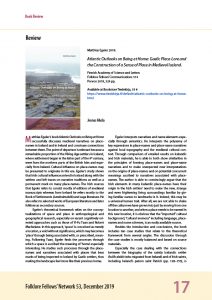Joonas Ahola
Matthias Egeler 2018: Atlantic Outlooks on Being at Home: Gaelic Place-Lore and the Construction of a Sense of Place in Medieval Iceland.
Finnish Academy of Science and Letters
Folklore Fellows’ Communications 314
Porvoo 2018, 324 pp.
Available at Bookstore Tiedekirja, 35 €
Matthias Egeler’s book Atlantic Outlooks on Being at Home successfully discusses medieval narratives on place-names in Iceland and in Ireland and construes connections between them. The point of departure is relevant because a remarkable proportion of the Viking Age settlers in Iceland, where settlement began in the latter part of the 9th century, were from the northern parts of the British Isles and especially from Ireland. Cultural influence on place-names may be presumed to originate in this era. Egeler’s study shows that Irish cultural influence arrived in Iceland along with the settlers and left traces on narrative traditions as well as a permanent mark on many place-names. The Irish sources that Egeler refers to consist mostly of editions of medieval manuscripts whereas from Iceland he refers mostly to the Book of Settlements (Landnámabók) and saga literature. He also refers to selected works of European literature and later folklore as secondary sources.
Egeler’s theoretical framework relies on the conceptualizations of space and place in anthropological and geographical research, especially on recent cognitively oriented approaches such as those of Yi-Fu Tuan and Robert Macfarlane. In this approach, ‘space’ is conceived as merely a location, a void without significance, which may become a ‘place’ through being associated with, or prescribed, meaning. Following Tuan, Egeler finds the processes through which a space is ascribed the meaning of ‘home’ especially interesting. He studies such processes through the place-names and narratives associated with places that bear marks of being imported to Iceland by Gaelic settlers, thus making the landscape feel more like their previous home.
Egeler interprets narratives and name elements especially through semantics. He interprets the polysemy of key expressions in place-names and place-name narratives against local topography and the medieval cultural context. Through comparison of entailed results on Icelandic and Irish materials, he is able to both show similarities in the principles of forming place-names and place-name narratives and to make unexpected new interpretations on the origins of place-names and on potential concurrent meanings ascribed to narratives associated with place-names. The author is able to convincingly argue that the Irish elements in many Icelandic place-names have their origin in the Irish settlers’ need to make the new, strange and even frightening living surroundings familiar by giving familiar names to landmarks in it. Indeed, this may be a universal human trait. After all, we are not able to shake off the culture we have grown into just by moving from one location to another, and when a place needs to be named in this new location, it is obvious that the “imported” cultural background, “cultural memory” including language, place-names and name schemes, is an easily available source.
Besides the introduction and conclusions, the book includes ten case studies that relate to the theoretical framework from several angles. The discussion through the case studies is mostly balanced and based on source materials.
Especially the case dealing with the connections between the biography of the saintly Icelandic settler Ásólfr alskik (who migrated from Ireland) and of Irish saints, including Ireland’s patron saint Patrick (pp. 128–155), is interesting and studied with care. Through this reading, Ásólfr’s biography appears as a truly fascinating synthesis of Icelandic and Irish, vernacular and learned schemas for representing a biography. It is likewise intriguing that the key to this reading may be found in the miracles ascribed to the saintly Ásólfr that are connected to fishing in River Írá (‘Irishman River’).
Another especially interesting case dealt with is the one of people transforming into monstrous bulls in both Icelandic and Irish medieval narratives (pp. 221–249). The Icelandic narrative appears in Eyrbyggja saga, which tells of events in the western part of Iceland where Irish influence and immigration seems to have been especially vivid. The account is peculiar and difficult to interpret solely on the basis of Icelandic culture. Egeler’s reading draws on Irish medieval sources and especially on the heroic narratives of the Ulster Cycle. It is able to provide a fascinating and convincing interpretation and to open a view into the multilingual society of the recently settled Iceland which only later became exclusively Norse speaking.
Egeler’s book is an admirable work of scholarship. Nevertheless, he is not completely immune to the very common pitfall in comparative research that theory or a hypothesis becomes a lens of interpretation and the interpretive lens can take the lead ahead of the evidence. While Egeler is generally very careful not to put the cart before the horse, so to speak, this seems to happen in his discussion of a brief narrative in Landnámabók about an extraordinarily strong horse that appears from a lake in the Snæfellsnes area (pp. 101–107). This horse performs incredible feats in pulling a hay sled and returns to the lake after breaking its harness. Egeler suggests that this narrative’s background is in an Irish heroic narrative of the Ulster Cycle that presents Cú Chulainn together with the mysterious grey horse Líath Macha. Indeed, the thematic similarities between these narratives seem to establish a connection between Iceland and Ireland. However, Egeler also brings into discussion 20th century local lore from Ireland’s county Aran. This tradition explains local geological formations that resemble hoof-prints as the hoof-prints of a singularly strong horse that had once appeared from the sea and returned there. By connecting such a tradition to the Icelandic narrative, Egeler seems to move into what Umberto Eco might call overinterpretation because the existence of such hoof-prints in the Icelandic case must be deduced from a mention that the horse’s hoofs would sink into the ground because of its efforts before the load.
Egeler also generally maintains a high level of source criticism, which is another common area where comparative studies easily stumble. There is however a case where he seems to take a few shortcuts – in the discussion on whether Hvanndalur in Iceland was considered in the Middle Ages to be a place in which people became immortal (pp. 198–207). In this section, descriptions of Icelandic local folklore from the 17th century provide a basis for interpreting an ambiguous text from the 13th century that claims to recount events that took place in the 10th century. The main argument is that the idea of immortality connected to a place was adopted from Ireland. The case is well put forward and the argument remains convincing, but the lack of source criticism here raises slight concerns.
Overall, the general argument that traditions of place of origin were applied to the surroundings in order to familiarize them is plausible, and the mass of case studies collectively provide a good quantity of circumstantial evidence in its support. However, individual cases, especially those that are casual and / or not contextually interlinked may sometimes appear confusing or selectively chosen. It is obvious that reconstructing the distant past on the basis of scarce sources requires imagination and, occasionally, intellectual leaps. Generalizations on the basis of different texts’ contents are necessary in comparative analysis, and, in practice, require disengagement from strict source criticism. In such cases, the line between speculation and grounded argumentation may be challenging to distinguish. For instance, the interpretation of a medieval text’s mode as “distancing irony” (pp. 78–79) requires hypotheses concerning the author’s intentions. On the other hand, medieval texts have tended to be read as very serious and Egeler illustrates the advantages of reading them in other ways. For instance, Mikhail Bakhtin’s Rabelais and His World (1968 [1965]) showed the relevance of considering the semantics of the grotesque in medieval texts and Egeler fruitfully applies this frame of interpretation for local traditions that may otherwise appear ambiguous or perplexing, leading to new and compelling interpretations.
For a reader who finds balanced self-criticism a virtue for innovative research, like I suppose most of us do, the concluding section of the book is of particular value. Egeler reviews his results and conclusions with the kind of perceptive touch that truly helps evaluating the relevance of the individual case studies and that helps make the big picture apparent. In addition to this, the transparent analysis and careful references to sources makes the book a weighty and useful contribution to the multidisciplinary research on the past and to place name studies in particular.

